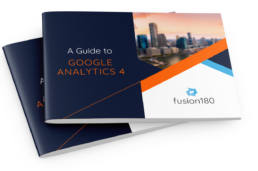
Understand the Updates
There are many differences between GA4 and GA Universal — some are welcome changes, while others, not so much. Here’s a breakdown of the most important differences between the two platforms:
GA4 vs. GA Universal
Can measure activity across all web properties in a single view (e.g. websites, mobile apps, etc.)
Requires multiple properties/views to measure activity across different websites and mobile apps
Uses a data model based on events and parameters
Uses a data model based on sessions and pageviews
Introduces new metrics like active users, engagement rate and average engagement time
Uses legacy metrics like bounce rate, unique pageviews and unique events, which are all being removed
Can automatically track many user touch points via pre-configured events
Requires custom events to measure nearly every user touch point
Reporting and data visualization capabilities are limited, so requires other Google products (e.g., BigQuery, Looker Studio, etc.) to leverage data to its full potential
Provides more options and flexibility for analyzing data and building reports directly in the UI, which minimizes the need to use other tools
GA4
Can measure activity across all web properties in a single view (e.g. websites, mobile apps, etc.)
Uses a data model based on events and parameters
Introduces new metrics like active users, engagement rate and average engagement time
Can automatically track many user touch points via pre-configured events
Reporting and data visualization capabilities are limited, so requires other Google products (e.g., BigQuery, Looker Studio, etc.) to leverage data to its full potential
vs
GA Universal
Requires multiple properties/views to measure activity across different websites and mobile apps
Uses a data model based on sessions and pageviews
Uses legacy metrics like bounce rate, unique pageviews and unique events, which are all being removed
Requires custom events to measure nearly every user touch point
Provides more options and flexibility for analyzing data and building reports directly in the UI, which minimizes the need to use other tools
What does this mean for you?
The good news is that as of July 1, 2023 marketers will benefit from the latest advances in data collection, cross-platform and cross-device tracking, and machine learning — all the while keeping user privacy in mind.
The bad news is any existing reports and dashboards will likely need to be rebuilt after the transition is complete. What’s more, to unlock the full power of GA4, other Google products (e.g. Tag Manager, BigQuery and Looker Studio) need to be integrated to make implementation, reporting and analysis easier.
We Can Help You Prepare for the Launch
Fusion180 specializes in analytics, data and technology for the marketing industry. We know the intricacies of the digital space and can help you make the move to GA4 seamlessly and successfully.
What We Do
- Craft an analytics strategy tailored to your business
- Lead the setup and technical implementation
- Validate data is accurate and coming in correctly
- Develop consistent and standardized naming conventions
- Build custom reports and dashboards for more informed decision making
- Integrate other Google products to unlock additional value
- Provide trainings so you can leverage the tech infrastructure to its max potential
- Assist both brands and agencies via direct and white-labeled partnerships
Don’t wait until it’s too late. Get ready for the TRANSITION TO GA4.
Power Your Next Project with Fusion180
Tell us about your needs and we’ll get back to you soon.
This site is protected by reCAPTCHA.
The Google Privacy Policy and Terms of Service apply.


